|
一、前言
就公路隧道或鐵路隧道而言,NMT是由許多各式各樣的隧道經驗所累積,這些低成本高技術的挪威隧道其開挖面積從45平方公尺到110平方公尺。下列是NMT的基本要素:
1.設計
(1)初期設計是根據現場的地質圖、鑽探岩心及震測結果。
(2)岩體品質描述採用Q值(Barton 1974;Barton 和Grimstad 1994)。
(3)根據施工過程所獲得隧道岩石品質及Q系統支撐建議來選擇最後支撐。
(4)大部份常用的永久支撐類別利用二向度離散元素(可分析節理)UDEC-BB程式及三向度3DEC(可分析3D節理)程式來確認。NGI所發展的UDEC-S(fr)可檢核噴凝土所承受的力。
(5)基本上採用NMT所設計的公路隧道是允許排水的,如果為了控制隧道內的水及霜凍,可採用混凝土隔版將水隔離。
2.合約
(1)業主支付技術上正確的支撐項目。
(2)承包商根據合約中所列的單價依實作數量計價。
(3)業主比承包商承擔較多的風險。
(4)所採用的支撐是由業主與承包商所同意的Q值,而且經常改變。
3.開挖及支撐
(1)一般採用鑽炸法開挖隧道,依地質現況選擇適當的開挖方法。
(2)臨時支撐如Sb,B或S(fr)是永久支撐的一部份。
(3)永久支撐類別是在隧道開挖過程中才選定。
(4)永久支撐一般是由高品質的濕式鋼纖噴凝土及全著型岩栓所構成,岩栓具有防腐蝕能力。
(5)岩盤地質條件很差時,才使用襯砌混凝土。
NMT不同於NATM:(1)NMT利用預言性的岩體分類於支撐設計,(2)NATM利用計測於支撐設計選擇,(3)NMT採用的永久支撐不是襯砌混凝土(除非需要),(4)NATM採用臨時支撐,襯砌混凝土為永久支撐,(5)NMT採用機械臂施噴鋼纖噴凝土(10-25m3/hr),(6)NATM採用鋼線網,一般採用手持乾式噴凝土。
由於濕式噴凝土反彈量低(一般是4% - 6%),及不採用內襯砌混凝土來防水,用於NMT與NATM隧道的混凝土量有很大的不同(NMT混凝土用量約只有NATM的1/2 – 1/5),施工工期也明顯受到影響。由於NMT採用機械化施工(機械臂、電腦控制鑽堡),隧道開挖面的工人每班只有三人。
NMT代表性特點,圖(一):
(1)根據露頭、岩心、隧道壁面的岩體特徵描述作為撐類別估算。
(2)當有震測資料可用時,可利震測資料來建立岩體品質。
(3)現地採用Q系統來選擇支撐類別。
(4)利用數值分析模式來確認依經驗設計的支撐系統。
(5)濕式噴凝土採用機械臂施噴。
|
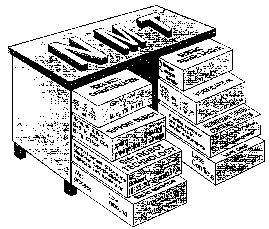
圖一 NMT設計與施工 |
三、岩體特性描述
在1970年利用Q系統來描述岩體特性,當時鋼纖噴凝土尚未問世(最早利用鋼纖噴凝土是1972年,應用於Ririe霸的隧道)。二十年來Q系統更新了兩次,是為了配合最近六年濕式鋼纖噴凝土技術及挪威所建立的經驗。現今的Q系統(Barton和Grimstad,1994)和二十年前的系統大致上沒有改變,只有在地應力的項目作了改進,岩體品質數(Q值)範圍改為0.001至1000,如此較能確實地反應隧道地質狀況的巨大變化,既從膨脹或擠壓岩盤和黏土到厚塊狀、無節理岩盤。Q值的計算公式由六個參數組成:
Q = (RQD/Jn)(Jr/Ja)(Jw/SRF)
六個參數是經驗評分,其評分如表一所示,並利用統計方法將六個參數摘要在如圖(二)。
表一 Q系統評分表(Barton and Grimstad, 1994)
| 1.Rock Quality Designation |
RQD |
| A |
Very poor |
0.25 |
| B |
Poor |
25.50 |
| C |
Fair |
50.75 |
| D |
Good |
75.90 |
| E |
Excellent |
90.100 |
| Note: |
i ) Where RQD is reported or measured as≦10(including 0),a nominal value of 10 is used to evaluate 0.
ii) RQD intervals of 5,i.e., 100,95,90,etc.,are sufficiently accurate. |
| |
|
| 2.Joint Set Number |
Jn |
| A |
Massive, no or few joints |
0.5.1.0 |
| B |
One joint set |
2 |
| C |
One joint set plus random joints |
3 |
| D |
Two joint sets |
4 |
| E |
Two joint sets plus random joints |
6 |
| F |
Three joint sets |
9 |
| G |
Three joint sets plus random joints |
12 |
| H |
Four or more joint sets, random, heavly jointed,
"sugar cube", etc. |
15 |
| J |
Crushed rock, earthlike |
20 |
| Note: |
i ) For intersections, use(3.0×Jn)
ii) For portals, (use2.0×Jn) |
| |
|
| 3.Joint Roughness Number
|
Jr |
| a)Rock-wall contact, and b) rock-wall contact before 10 cm shear |
| A |
Discontinuous joints |
4 |
| B |
Rough or irregular, undulating |
3 |
| C |
Smooth, undulating |
2 |
| D |
Slickensided, undulating |
1.5 |
| E |
Rough or irregular, planar |
1.5 |
| F |
Smooth, planar |
1.0 |
| G |
Slickensided, planar |
0.5 |
| Notel: |
i ) Descnptions refer to small scale features and intermediate scale features, in that order. |
|
| c)No rock-wall contact when sheared |
| H |
Zoon containing clay minerals thick enough to prevent rock-wall contact |
10 |
| J |
Sandy,gravelly or crushed zone thick enough to prevent rock-wall contact |
10 |
| Note: |
i ) Add 1.0 if the mean spacing of the relevant joint set is greater than 3m
ii) Jr = 0.5 can be used for planar slickensided joints having lineation, provided the lineations are oriented for minmum strength. |
| |
|
| 4.Joint Alteration Number
| ∮r
approx. |
Ja |
| a)Rock-wall contact (no mineral fillings, only coatings) |
|
| A |
Tightly healed, hard, non-softening, impermeable filling, i.e., quartx or epidote |
|
0.75 |
| B |
Unaltered joint walls, surface staining only |
25-35° |
1.0 |
| C |
Slightly altered joint walls. Non-softening mineral coatings, sandy particles, clay-free disintegrated rock, etc. |
25-30° |
2.0 |
| D |
Silty-or sandy-clay coatings, small clay fraction (non-softening) |
20-25° |
3.0 |
| E |
Softening or low fnction clay mineral coatings, i.e., kaolinite or mica. Also chlorite, talc, gypsum, graphite, etc., and small quantities of swelling clays. |
8-16° |
4.0 |
| b)Rock-wall contact before 10 cm shear (thin mineral fillings) |
|
| F |
Sandy particles, clay-free disintegrate drock, etc. |
25-30° |
4.0 |
| G |
Strongly over-consolldated non-softening clay mineral fillings (continuous, but<5mm thickness) |
16-24° |
6.0 |
| H |
Medium or low over-consolidation, softening, clsy mineral fillings(continuous, but<5mm thickness) |
12-16° |
8.0 |
| J |
Swelling-clay fillings, i.e., montmorillonite (continuous,but<5mm thickness).Value of Ja depends on percent of swelling clay-size particles, and access to water, etc. |
6-12° |
8-12 |
| c)No rock-wall contact when sheared(thick minaral fillings) |
|
| KLM |
Zones or bands of disintegrated or crushed rock and clay (see G, H, j for description of clay condition) |
6-24° |
6, 8, or
8-12 |
| N |
Zones or bands of silty-or sandy-clay, small clay fraction(non-softening) |
- |
5.0 |
| OPR |
Thick, continuous zones or bands of clay (see G, H, J for description of clay condition) |
6-24° |
10, 13,
or 13-20 |
|
| 5.Joint Water Reduction Factor |
Jw |
| A |
Dry excavations or minor inflow, i.e.,<5mm 1/min locally |
10 |
| B |
Medium inflow or pressure, occasional outwash of joint fillings |
0.66 |
| C |
Large inflow or high pressure, in competent rock with unfilled joints |
0.5 |
| D |
Large inflow or high pressure, considerable outwash or joint fillings |
0.33 |
| E |
Exceptionally high inflow or water pressure at blasting, decaying with time |
0.2.0.1 |
| F |
Exceptionally high inflow or water pressure continuing without noticeable decay |
0.1.0.05 |
| Note: |
i ) Factors C to F are crude estimates. Increase Jw if drainage measures are installed.
ii) Special problems caused by ice formation are not considered |
| |
|
| 6.Stress Reduction Factor |
SRF |
| a)Weakness zones in intersecting excavation, which may cause lossening of rock mass when tunnel excavated |
| A |
Multiple occurrences of weakness zones containing clay or chemically disintegrated rock, very loose surrounding rock (any depth) |
10 |
| B |
Single weakness zones containing clay or chemically disintegrated rock (depth of excavation≦50m) |
5 |
| C |
Single weakness zones containing clay or chemically disintegrated rock (depth of excavation>50m) |
2.5 |
| D |
Multiple shear zones in competent rock (clay-free), loose surrounding rock (any depth) |
7.5 |
| E |
Single shear zones in competent rock (clay-free) (depth of excavation≦50m) |
5.0 |
| F |
Single shear zones in competent rock (clay-free) (depth of excavation>50m) |
2.5 |
| G |
Loose, open joints, heavily jointed or "sugar cube" .etc (any depth) |
5.0 |
| Note: |
i ) Reduce these values of SRF by 25.50% if the relevant shear zones only influence but do not intersect the excavation |
| b)Competent rock, rock stress problems |
σ3 /σ1 |
σθ /σc |
SRF |
| H |
Low stress, near surface. Open joints |
200 |
<0.01 |
25 |
| J |
Medium stress, favourable stress condition |
200.10 |
0.01.0.3 |
1 |
| K |
High stress, vary tight structure Usually favourable to stability, may be unfavourable for wall stability |
10.5 |
0.3.0.4 |
0.5.2 |
| L |
Moderate slabbing after 1 hour in massive rock |
5.3 |
0.5.0.65 |
5.50 |
| M |
Slabbing and rock burst after a few minutes in massive rock |
3.2 |
0.65.1 |
50.200 |
| N |
Heavy rock burst (strain burst) and immediate dynamic deformations in massive rock |
<2 |
>1 |
200.400 |
| Note: |
ii ) For strongly anisotropic virgin stress field (if measured) when 5≦σ1 /σ3≦10. Reduce σc to 0.75σc whenσ1 /σ3 >10. Reduce σc to 0.5σc' where σc = unconfined compression strength, σ1 and σ3 are the major and minor pnncipal stresses, and σc = maximum tangential stress (estimated from elastic theory)
iii ) Few case records available where depth of crown below surface is less than span width. Suggest SRF increase from 2.5 to 5 for such cases(see H). |
| C)Squeezing rock :plastic flow of incompetent rock under the influence of high rock pressure |
σθ /σc |
SRF |
| O |
Mild squeezing rock pressure |
1.5 |
5-10 |
| P |
Heavy squeezing rock pressure |
>5 |
10-20 |
| Note: |
iv ) Cases of squeezing rock may occur for depth H > 350Q1/3(Singh et al., 1992). Rock mass compression strength can be estimated from q = 0.7 γ Q | 1/3 (Mpa) where r = rock density in kN/m3(Singh,1993)
| d)Swelling rock: chemical swelling depending on presence of water |
| R |
Mild swelling rock pressure |
5-10 |
| S |
Heavy swelling rock pressure |
10-15 |
| Note: |
Jr and Ja classification is applied to the joint set or discontinuity that is least favourable for stability both from the point of view orientation and shear resistance, T ( where T =σn tan-1(Jr / Ja)
Choose the most likely feature to allow failure to initiate |
| |
Q = |
RQD |
× |
Jr |
× |
Jw |
|
| Jn |
Ja |
SRF |
|
|
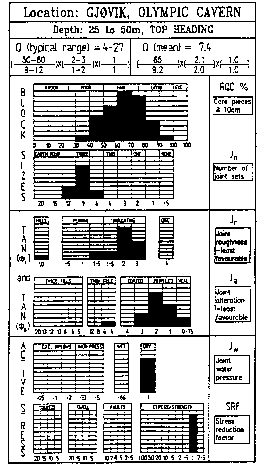
圖二 Q系統參數統計圖 |
|
四、經驗支撐設計
圖(一)中左邊第二個圖列出永久性支撐代表性方法,支撐建議是根據1250個案例。經驗支撐設計技巧如圖(三)所示。對公路和鐵路隧道(地下水力發電廠)ESR = 0.9 – 1.1,輸水隧道ESR = 1.6 – 2.0,ESR因素修正支撐程度,也因此修正成本及安全水準。
依據NMT原理,岩體分類主要用來支撐類別選擇而非監測,然而就隧道的行為及岩體品質,監測資料可提供有用的判斷,Barton et al(1994)建議隧道壁面變位:
(mm)=SPAN(m)×σc)1/2 ×Q
假設SPAN=10m,Q=0.01,H=100m,σc=10MPa,△=316mm。
五、岩栓設計
同一輪進的岩栓其長度依實際狀況而變,數值分析可用來確認岩栓所需的長度,最佳的岩栓設計是考慮岩栓承受最大荷重的地方,同時考慮岩栓的斷面大小。對於變形性較大的地盤,容許較大變形的環氧樹脂玻璃纖維岩栓較為適合。不同承載力及勁度的岩栓會影響噴凝土內部所承受的力。
NMT採用B+S(fr)(岩栓+濕式鋼纖噴凝土)作為永久性支撐,不需襯砌混凝土,所以鋼纖及岩栓須具有防腐蝕功能。岩栓受防蝕處理、黏著劑及PVC套管保護,或採用玻璃纖維岩栓。
六、鋼纖噴凝土
1974年的Q系統支撐建議只有噴凝土或加舖鋼線網S(mr),1984年濕式鋼纖噴凝土S(fr)首次商業上應用於挪威的水力電廠計畫,因此大約到1984年以後,S(mr)在挪威已不再使用,原因是S(fr)的施噴技術有戲劇性的成功進展,
|
其中包括機械臂噴漿機的高噴量(25m3/hr)、高品質、低反彈量。圖(一)中左邊第三個圖摘要現代噴凝土的關鍵要素,其在安全的、迅速的及經濟的隧道施工方面代表著一種革命。
S(fr)的關鍵性質包括很低的滲透率,鋼纖受到保護(噴凝土品質好,低含水量,W/(C+F)=0.4 – 0.45),S(fr)變形時吸收破裂的能量為純噴凝土的30至40倍,且等於二層鋼線網噴凝土。S(fr)的另一優點是S(fr)可以密貼於不平整的岩壁面(鋼線網是不可能,會形成孔洞,增加腐蝕的潛在性)。S(fr)可以和所有岩壁密合,可發揮最高的可能的黏著力、凝聚力及磨擦力。
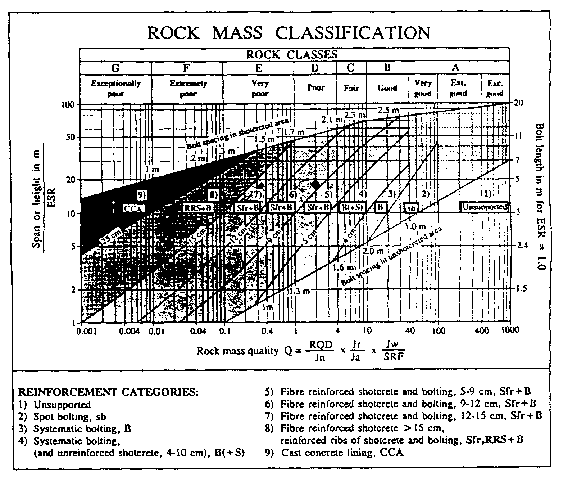 圖三 Q系統隧道補強材料設計圖(Grimstad Barton, 1993)
圖三 Q系統隧道補強材料設計圖(Grimstad Barton, 1993)
七、震測推估岩石品質
對於未來的隧道計畫,利用震測來調查地層的低速帶所在位置最為便利,但其主要問題是如何利用震測資料來推估岩體品質。淺層硬岩岩盤的震波折射法(深度等於或小於25m),Barton et al(1992)建議:
Vp=log10Qc=3.5 km/s (1)
Vp=是P波速度
Qc=Q×σc/100
圖(四)說明Qc與Vp、深度、岩體組構孔隙、單軸抗壓及岩體變形模數的關係,岩石孔隙率n越大,Vp越小,深度越大,Vp越大,地層深度等於或小於25m時,利用(1)式須考慮n值作修正,地層深度等大於25m時,Vp亦須修正。對較大深度地層,如果可能,可採用孔內震測,由於深度較大,節理較為緊閉,岩盤據有較高的彈性波速及變形模數,但可能無法提高隧道隧道品質(Q值),因為高應力產生擠壓、壓碎或板裂(slabbing),抵消因節理較為緊閉使岩盤具有較高的彈性波速及模數,所以應用Qc-Vp關係要小心。假設Q值=2,σc=50MPa,Qc =2×50/100=1,假設n = 10﹪,隧道深度是100公尺,n減少Vp,隧道深度增加Vp,兩者效用幾近相抵消,所以採用(1)式預估現地Vp=3.5km/s及變形模數M=10GPa。M = 10QC1/3 GPa。
八、數值分析確認
Q系統所建議的隧道支撐系統,包括岩栓間距、鋼纖噴凝土厚度、鋼肋加勁噴凝土(RRS)或場鑄混凝土拱(CCA)(岩盤差者),是根據經驗關係。在決定支撐系統時,仍然需要考慮岩栓的承載力及勁度,檢核噴凝土所承受的荷重。因此NMT設計亦採用數值分析來幫助了解支撐潛在的異常承受荷重,改進基本的經驗的設計。如圖(五)所示,對於Q<0.1,可採用破碎地盤為連續體模式,對於0.1<Q<100,節理可採用二向度UDEC或三向度3DEC來模擬。Flac程式(連續體模式)無法實際描述離散節理岩盤的變形行為。
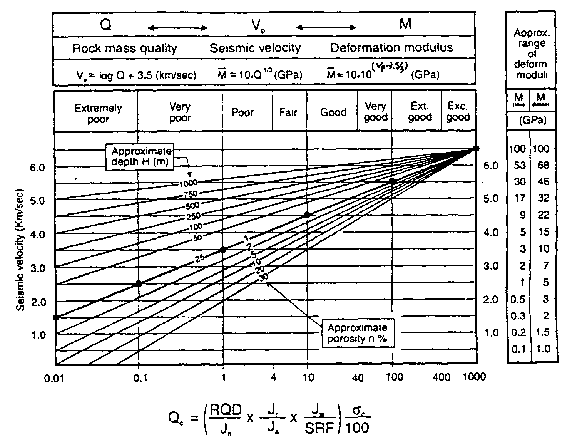 圖四 震波速度與岩石品質、靜泰變形模數關圖(Barton, 1995)
圖四 震波速度與岩石品質、靜泰變形模數關圖(Barton, 1995)
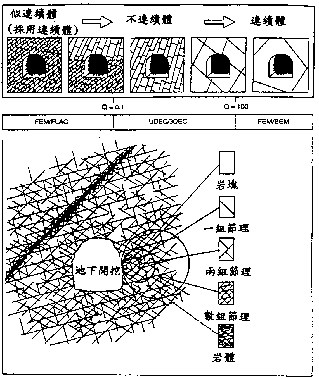
圖五 Q值與數值分析模式關係圖(修正自Hoek, 1983) |
|
九、鋼纖噴凝土數值分析模式
當新鮮岩壁具有高度粗糙度時,適當選擇鋼纖噴凝土黏著力,將發現噴凝土與岩壁間會有潛在很高的磨擦強度,圖(六)可用來估算S(fr)與岩壁間的強度。
十、岩栓防腐蝕保護
B+ S(fr)作為隧道永久支撐給予設計者很大的負擔(50年或100年的隧道設計年限),挪威採用CT(Combi-Tube)解決了此問題,如圖(七)所示。PVC套管將灌漿液分為兩層,岩栓桿件經鍍鋅處理,並塗上環氧樹脂,機械式錨端為臨時錨定。岩栓可在噴凝土前或後灌滿漿液。噴凝土後岩栓灌漿需預留灌漿管。在岩盤具有低變形模數及岩栓勁度較大與岩盤變形無法協調時,採用玻璃纖維岩栓灌置環氧樹脂或合成樹脂亦可解決腐蝕問題。
十一、乾燥的NMT隧道
圖(八)說明NMT沒有鋼肋及有鋼肋的支撐型式。NMT隔離水及霜凍如圖(九)所示,有四個重點需要強調得:
(1)隧道要排水但要維持乾燥(預先灌漿止水)。
(2)節省大量混凝土數量。
(3)需要可靠NMT岩盤加勁(因為是永久的隧道支撐)。
(4)需要低的維護。■
|
| MDEC-S(fr)之S(fr)輸入資料 |
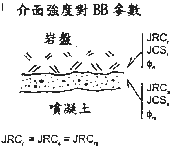 |
1)當δc(岩石)>δc(噴凝土),JCSsΦ及rs是最弱的連結
2)當δc(岩石)<δc(噴凝土),JCSs及Φrr是最弱的連結 |
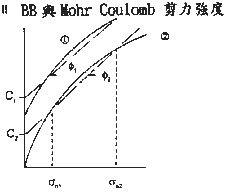 |
1)握裏失敗前的剪力強度
2)握裏失敗後的剪力強度
 |
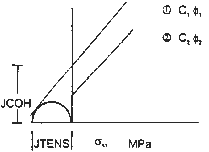 |
Ⅲ 作用在噴凝土的正方向應力
•典型平均支撐壓力P
岩栓10t/m2=0.1 Mpa
•假設平均支撐壓力P
噴凝土=0.01∼0.1Mpa |
| 由於非常低的正向應力,Φ1及Φ2很高,既大於50°因此JCOH>JTENS |
| 假設 σe/σ1for S(fr)=10/1 |
| 假設JTENS(Mpa)=(差) 0.25←→1.0(好) |
圖六 估算岩壁-S(fr)間的強度的方法
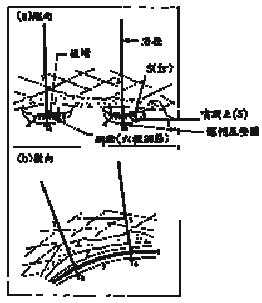 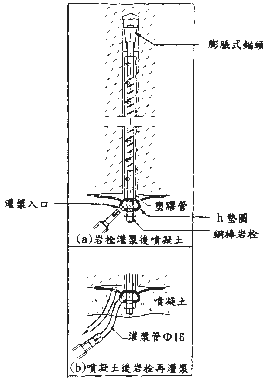 圖七 挪威CT岩栓示意圖
圖八 支撐系統縱向及橫向示意圖
圖七 挪威CT岩栓示意圖
圖八 支撐系統縱向及橫向示意圖
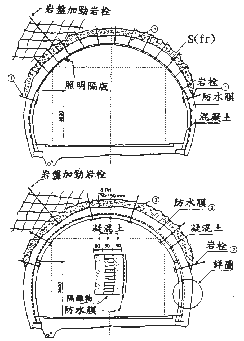 圖九 NMT隧道襯砌具有排水設施,但車道是乾燥的(Kveldsvik及Karlsrud, 1995)
圖九 NMT隧道襯砌具有排水設施,但車道是乾燥的(Kveldsvik及Karlsrud, 1995)
參考文獻:
1. Nick Barton & Panayiotis Chryssanthakis(1996) "Design of Tunnels for NMT Using Fibre Reinforced Shotcrete and Bolting as Permanent Support", Second International Symposium on Sprayed Concrete.
|











